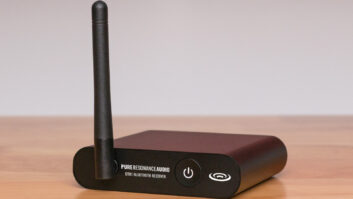Each of the suspended loudspeakers inside Berlin’s Hamburger Bahnhof – Museum of the Present replayed fragments of “The Last Post” performed on mangled brass and woodwind instruments salvaged from battlefields.

During a recent trip to Berlin for the AES Convention, and then to London for the V&A Exhibition, I encountered a pair of sound-centric art installations.
At Berlin’s Hamburger Bahnhof – Museum of the Present, a multi-room exhibition entitled “Moving is in Every Direction – Environments | Installations | Narrative Spaces,” features the work of a number of innovative artists, including Susan Philipsz, who won the 2010 Turner Prize for her sound installations using a cappella versions of songs replayed over a PA system. Currently living and working in the German capitol, for this show Philipsz had offered “War Damaged Musical Instruments,” which comprises multiple recordings of artifacts salvaged from battlefields, ranging from a bugle used at the Battle of Waterloo, to a tuba from the trenches of the first world war, and a bugle salvaged from the Alte Münz bunker, Berlin, in 1945. Each of the suspended loudspeakers replayed fragments of “The Last Post” performed on these mangled and barely functional brass and woodwind instruments, ranging from a sharp bugle note, a sonorous gasp and a noise like wind in a drainpipe.
The installation uses audio from numerous mangled instruments, including a ruined coronet played in the Boer war.

The far end of the space featured playback of a bugle that reportedly sounded the charge of the Light Brigade at the 1854 Battle of Balaclava during the Crimean War. At the other end, a B flat bugle found by the body of a 14-year-old drummer boy after the Battle of Waterloo sounds a few notes. In between is a recording of a tuba recovered from the German trenches in 1915, a cavalry trumpet salvaged from a ship torpedoed by a submarine off Portland Bill in 1918, a ruined coronet played in the Boer war, plus instruments recovered from the Alte Münz bunker in Berlin, and from battles in Hanover and Bavaria. Most instruments were borrowed from military museums.
The myriad sounds were truly haunting, with added reverb to place them in a more lyrical environment. The gallery space also echoed with a call and response from one war to another, and one battlefield to another. They recalled the final breaths and even death rattles, with slow exhalations. Yet the music – if it is, indeed, music – could be considered uplifting while also representing a mournful mixture of distant and close sounds replayed through injured instruments.
Bruce Nauman’s “Raw Materials” is presented inside the Tate Modern Turbine Hall on London’s South Bank.

And within the Tate Modern Turbine Hall on London’s South Bank, adjacent to the River Thames, US conceptual artist Bruce Nauman is currently presenting “Raw Materials,” described as a “restless exploration of different media that reflects a continual questioning and reinvention of an artistic practice.” His sound installation, first shown at this venue in 2004, brings together 21 recordings of texts taken from earlier works that span almost 40 years of his career. Walking through the Turbine Hall, disembodied voices speak to the visitor in a variety of styles from flat-panel speakers. For example, one playback source produces stark texts like “OK OK OK” that Nauman chants repeatedly until the phrase distorts and seems to morph into new words. Longer pieces, such as “False Silence” or “Consummate Mask of Rock,” are cryptic narratives that describe psychological states at odds with the calm voice delivery. Somewhere in between is “Get Out of My Mind, Get Out of This Room,” in which Nauman repeats the statement as if on the edge of asphyxiation, his gasps and snarls building an atmosphere of claustrophobia and intimidation.
The artist’s interest in lexical systems is said to share something with the plays of Samuel Beckett or the philosophy of Ludwig Wittgenstein; his fascination with deconstructing language and exposing its inherent ambiguities is paralleled by his approach to making art. In these work, he asserts, “the boundaries between sculpture, sound and language are blurred.” “The range of material and presentations and intentions is important to the richness and density of the experience,” he states in the show’s program.







